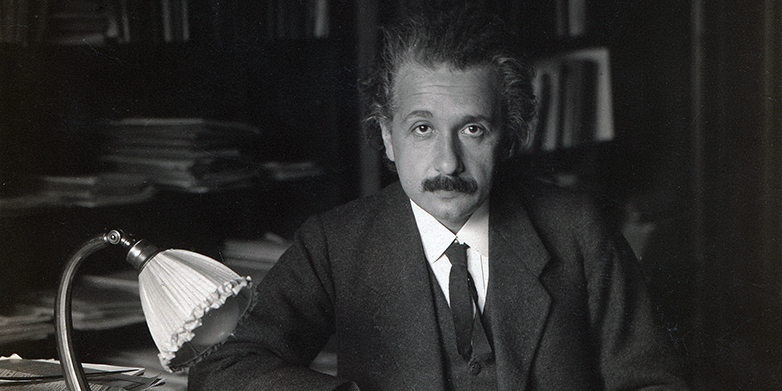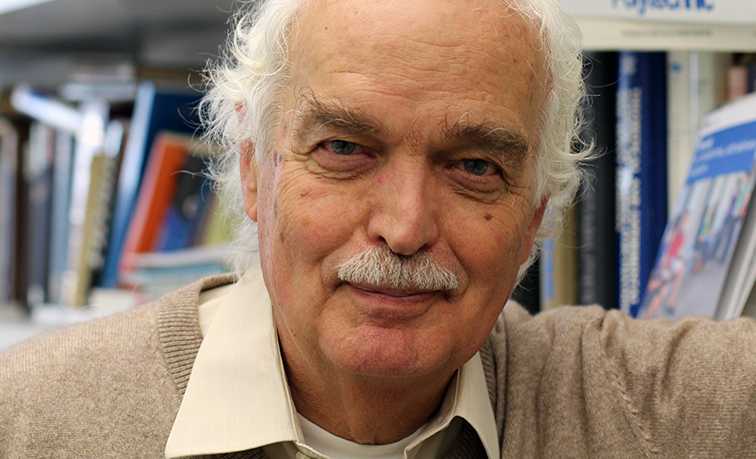“It's scarcely possible to grasp intuitively”
In November 1915, Albert Einstein presented the general theory of relativity. A symposium at ETH Zurich celebrates the 100th anniversary of this groundbreaking theory from 12 to 14 November.
ETH News: Hans-Rudolf Ott, you are one of the organisers of the symposium on 100 years of the general theory of relativity. What exactly happened in November 1915?
Ott: Within just one month, Albert Einstein submitted four publications on the general theory of relativity to the Prussian Academy of Sciences. Ten years previously he had formulated a new understanding of space and time, which today we know as the special theory of relativity. According to the special theory, both space and time are dependent on the reference frame and relative motion of the observer. Other deliberations on generalising the theory of relativity led Einstein to develop a theory of gravitation. Due to the mathematical difficulties, Einstein was only able to present his general theory of relativity in a form that he regarded as satisfactory in 1915 in Berlin.
Between 1909 and 1914, Einstein was, among other engagements, first a professor at the university and then at ETH Zurich. How much Zurich is in the general theory of relativity?
Einstein substantially developed his theory during his time as a professor at ETH. Together with his friend Marcel Grossmann, who served as a professor of mathematics at ETH Zurich, Einstein drafted his Outline of a Generalized Theory of Relativity in 1913, which came very close to the later version of the general theory of relativity presented in 1915. Grossmann contributed decisively to the mathematical part of the theory.
How was the general theory of relativity received?
The general theory of relativity is significantly more complex in form and more mathematical than the special theory of relativity. Initially there were very few people, even in scientific circles, who really understood it. That is due in part to the fact that the theory is scarcely possible to grasp intuitively.
What do you mean?
Our GPS satellite navigation system, for example, would be useless if it didn't take relativity effects into account. Relativity effects influence time measurement, that is, the rate of the clocks used. Both the relative motion of the satellites in relation to earth as well as the difference in gravity between the satellites and the surface of the earth influence the rate of the clocks. Both factors have to be taken into account for the purposes of navigation. That is difficult to apprehend intuitively, which is why the experimental proofs of the general theory of relativity were all the more important. Then in 1919, the gravitational deflection of light postulated by Einstein was demonstrated experimentally and Einstein became a sort of pop star of the physics world.
How great is the significance of the theory today?
Without the general theory of relativity, modern physics as we know it would not be possible. It is central to our understanding of the cosmos. Incidentally, the theory has been confirmed in all tests and experiments to which it has been subjected. There are still open questions, however.
Such as?
In the near future, efforts will be undertaken to directly prove the existence of gravitational waves, whose existence Einstein postulated on the basis of his theory. An important step in that process is the LISA Pathfinder project (cf. ETH News 4.12.2013), in which the University of Zurich and ETH Zurich are involved. No one doubts, however, that the existence of gravitational waves will indeed be proven. The greater challenge will be to unite the general theory of relativity with quantum mechanics. This will be the only way to resolve certain unanswered questions, such as how the universe could have come into being or what happens in black holes.
Is Albert Einstein still a pop star?
The name Einstein has developed into a veritable brand. Events related to him and his work still draw large crowds. It is astonishing that a single person – initially outside of academia – could accomplish such a number of extraordinary scientific achievements. The fascination is surely due in part to the fact that while most people do not understand his theories, they do have the feeling that they are relevant and coherent. With our symposium, we want to do our part in making his theories more familiar and more understandable to the public.
About Hans-Rudolf Ott
Hans-Rudolf Ott is professor emeritus of physics at ETH Zurich and president of the Albert Einstein Gesellschaft Bern.
Einstein and Zurich

Albert Einstein studied physics at the Federal Polytechnic Institute – today's ETH Zurich – from 1896 to 1900. Later he worked for the Federal Patent Office in Bern, but continued to do scientific work. In July 1905, he submitted his dissertation A New Determination of Molecular Dimensions at the University of Zurich. Among Einstein's publications in his annus mirabilis of 1905 were the special theory of relativity and the light quanta hypothesis, for which he later received the Nobel Prize in Physics. In 1909, Einstein was appointed associate professor at the University of Zurich. After a short spell as a professor in Prague, in 1912 he returned to Zurich – this time as a full professor of theoretical physics at the Polytechnic. One-and-a-half years later he moved to Berlin. Even a generous offer of a joint professorship at the University of Zurich and ETH Zurich was not enough to lure him back to Switzerland.
100 years of general relativity – symposium
The symposium (12 to 14 November 2015; ETH Zurich) is open to the public, though the lectures on 12 November are directed at experts. The events on Friday and Saturday are open to the public and will be more accessible to a broader audience.

